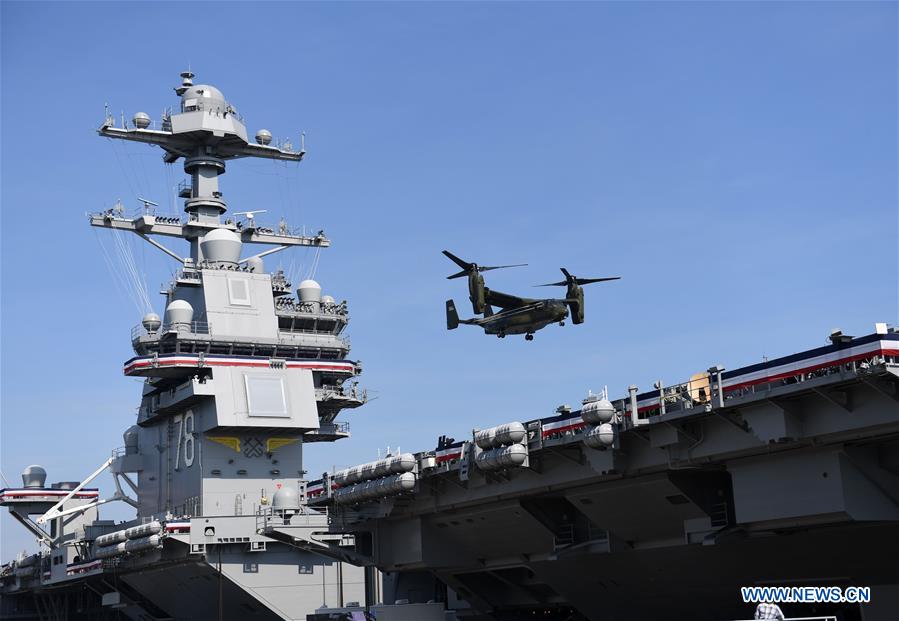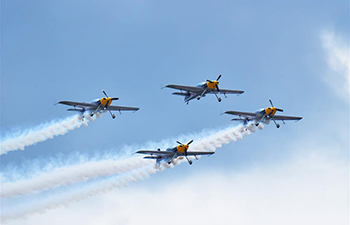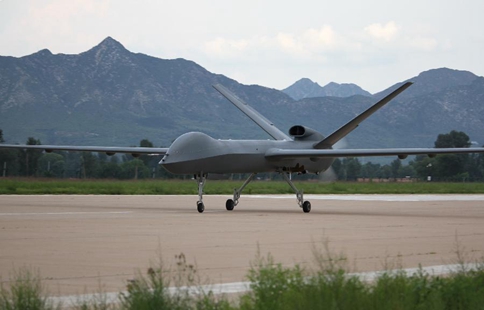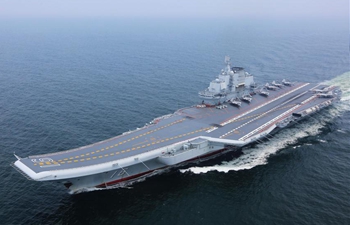
A U.S. Marines MV-22B Osprey lands on USS Gerald R. Ford for its commissioning ceremony at Naval Station Norfolk, Virginia, the United States, on July 22, 2017. The U.S. Navy commissioned United States Ship (USS) Gerald R. Ford, the newest and most advanced aircraft carrier, at Naval Station Norfolk, a navy base in Virginia on Saturday. (Xinhua/Yin Bogu)
WASHINGTON, July 22 (Xinhua) -- The U.S. Navy commissioned United States Ship (USS) Gerald R. Ford, the newest and most advanced aircraft carrier, at a naval base in Virginia on Saturday, as President Donald Trump promises more budget to beef up defense.
Trump presided over the Ford's commissioning on Saturday morning at Pier 11 on Naval Station Norfolk, a navy base in the Commonwealth of Virginia, in the presence of high-ranking U.S. officials, military officers, sailors, and crowds of civilians, in an intense heat.
MORE MILITARY BUDGET PROMISED
"After today where this ship sails, you will all carry a proud title -- plank owner of the USS Gerald R. Ford," Trump said at the commissioning.
While praising what he described as an "incredible achievement" in building the Navy's latest and largest ship, Trump expressed his dissatisfaction with an insufficient input in new military technology and a decline in military readiness under the previous administration.
"It's been a very, very bad period of time for our military," Trump told service members as he highlighted his efforts to ask Congress for a 54-billion-U.S.-dollar extra budget for military purposes next year.
"You will get it. Don't worry about it," said the Republican president.
However, the 13-billion-dollar vessel equipped with an advanced electromagnetic jet-launching system, was seriously criticized by Trump earlier.
In May, Trump urged the Navy to go back to using steam catapults to launch aircraft because the electromagnetic systems "cost hundreds of millions of dollars more and it's no good."
Among a host of officials were U.S. Secretary of Defense James Mattis, former Defense Secretary Donald Rumsfeld, and Virginia Governor Terry McAuliffe.
McAuliffe told Xinhua that the carrier, built by 9,000 Virginians, is the most sophisticated fighting ship that the United States has ever built.
Addressing the crowd, the governor called for more military contracts to be put into the commonwealth as Trump promised to "deliver on time and ahead of budget".
According to the original schedule, the most expensive U.S. military vessel whose construction work started in 2009, shall be delivered in 2015 and at a cost of 10.5 billion dollars, but the delivery was delayed several times until late May this year due to technological obstacles and overspending. "We want the best equipment," Trump said, "We want it built ahead of schedule and we want it built under budget."
NEXT-GENERATION AIRCRAFT CARRIER
The vessel, the first of the next generation of nuclear-powered U.S. aircraft carriers, is named after the country's 38th president Gerald R. Ford.
Susan Ford, Ford's daughter and the ship's sponsor, gave the command to set the warship on its path to sea after being placed in commission by Trump. Captain Richard McCormack then officially took over the helm of the warship.
Based on the U.S. navy's first new aircraft carrier design in 40 years, the 1,100-foot (about 335.2 meter) nuclear-powered supercarrier is equipped with the electromagnetic catapults and advanced operational systems that allow aircraft to take off and land more quickly and downscale the crew.
The new technologies launch a third more fighter jets than traditional systems in older carriers, with less heat and noise.
Besides, the 100,000-ton warship has a larger deck to improve aircraft maneuverability and a repositioned, smaller tower for better visibility. Two nuclear reactors allow the Ford to cruise at a speed of more than 30 knots (unit of speed, 30 knots=55.56 km/h) and run for over 20 years without refueling.
There will be a crew of 2,600 sailors on the USS Ford, about 600 fewer than a Nimitz-class aircraft carrier, which is expected to save over 4 billion dollars over the ship's 50-year lifespan, according to the U.S. Navy.
There are 10 U.S. carriers being operated in the 11 carrier-force mandated by Congress, after the retirement of the USS Enterprise in 2012.
In addition to the USS Ford, there are two other aircraft carriers of its class. The USS John F. Kennedy is scheduled to launch in 2020, and the Ford-class USS Enterprise to begin construction in 2018.
The USS Ford, having completed sea trials in April, will go through a series of tests and inspections before going into operation and deployment.
U.S. Congress's auditors estimated in a report earlier this month that the follow-up work will take four years and cost an additional 780 million dollars.















